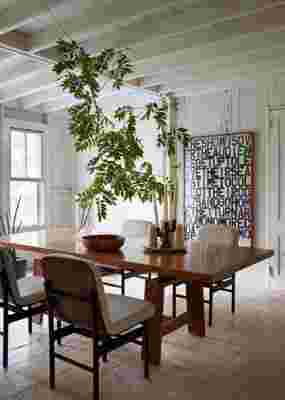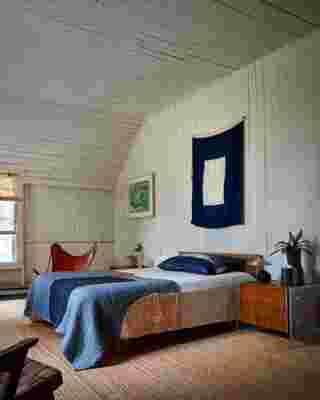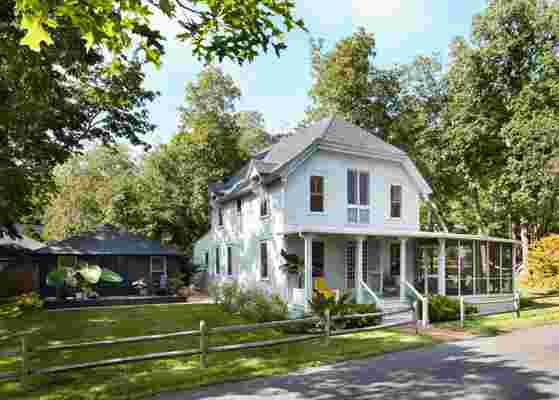The home as calling card is a well-worn metaphor for the private abodes of top interior designers. But the Shelter Island, New York, retreat of Esteban Arboleda is no slick showcase. “It’s not a laboratory,” says the decorator, associate partner at the celebrated Manhattan-based firm Haynes Roberts . “My house is my house. It’s a representation of who I am as a person, of my broad interests not just in my design life but in my life, period.”
Those idiosyncratic passions have found a worthy outlet for expression in Shelter Island Heights—a short distance but a world away from the swank and polish of the Hamptons homes for which Haynes Roberts is so beloved. Founded in the late 19th century as a summer getaway for members of the Brooklyn Methodist Church, and now listed on the National Register of Historic Places, this picturesque enclave is still dotted with its original seasonal cottages, designed in exuberant Victorian fashion with high-pitched roofs and gingerbread details. Over the decades, the salt air has taken its toll, but a carefree, communal spirit has endured—a little bit Brigadoon, a little bit Wes Anderson. “It’s out of a fairy tale,” Arboleda notes of the neighborhood, which he describes as “the witchiest, most mystical Scandinavian fantasy land.”

1970s Brazilian side chairs surround the dining room’s circa-1964 table by Silvio Coppola for Bernini; the framed artwork is a Christopher Wool poster.
He and his husband, David Haskell—a creative polymath who, in addition to being the editor in chief of New York Magazine and a celebrated ceramic artist, cofounded Kings County Distillery —happened upon the property by chance, absentmindedly scrolling Trulia on a visit to Long Island’s North Fork. “It was very different from anything else for sale,” Haskell recalls of the house, whose uninsulated Stick-style construction precludes winter occupancy, with baseboard heating that, in the warmest of weather conditions, can extend the spring–summer season into April and October. “It probably didn’t make sense for a lot of people but it was immediately clear to us that the place had personality. We just felt focused on specialness.”
After buying the property, which spans three original lots, two of them undeveloped, the couple set about preserving the character that had emerged across the home’s timber walls, floors, and chamfered beams. “So many people yearn for this patina,” Arboleda notes of the chipping paint and weathered finishes. “It was perfect, so relaxed and lived-in and unpretentious.” He and Haskell took special care to maintain that timeworn spirit, using a gentle bleach-infused tincture to strip away any dirt. “That first summer we did no work, we just got everything to a clean slate.”

A vintage nautical flag and framed 1950s map of Shelter Island hang in the main bedroom, where a pair of 1970s lucite-and-burlwood end tables by John Stuart flank a Case Study bed by Modernica ; the quilt is by Cold Picnic from Coming Soon .
Every summer since has been a new push—replacing the roof, repainting the house and its adjacent garage, creating a basement ceramics studio for Haskell, and updating the kitchen, which had been painted in Ronald McDonald shades of yellow and red. Along the way, Arboleda has deftly layered the rooms with an array of vintage finds, many of them auction purchases or treasures discovered at Long Island tag sales and thrift stores. “I like things that have a sense of humor and playfulness, but I also like architectural rigor and old rattan, and I like combining all that with a Colombian carpet or Stilnovo sconces,” notes Arboleda. “The house accepts it all. You can bring in a lot of things from different eras.” It’s an ease, of course, that only comes with expertise. Notes Haskell, very much in awe of his other half, “there is a lot of talent in being able to pull all that together in a way that is inviting and not chaotic.”
There are also stories to every piece and Arboleda, a connoisseur with a flourish for detail and an appetite for the obscure, delights in telling them. The cantilevered bedside tables in both guest rooms, he notes, had been designed for an Italian ocean liner. “Somehow I found this website that, for just a flash, had all these salvaged antiques from boats of the 20th century, the carcasses of these glorious ships,” he recalls. “They were rescued out of oblivion.” That yellow injection-molded plastic chair—originally created by Marc Newson for the Paris outpost of Walter Van Beirendonck’s WL&T concept store, was a gift from the couple’s longtime friend Paul Donzella, whose namesake gallery now represents Haskell. And all those woven baskets are one-of-a-kind souvenirs that Arboleda brought back from his many trips to Colombia, where he grew up. As he puts it: “It’s about obsessing and collecting no matter how uncomfortable the flight.”

Buy now for unlimited access and all of the benefits that only members get to experience.
The final push, still ongoing, has been the landscape, a true collaboration for the couple. A retaining wall of stacked rocks (what Haskell calls “the simplest thing possible”) now frames a sunken pea-gravel garden, with an array of succulents and potted plants in a constrained green palette. Planters have become a new shared obsession—in particular, 1960s finds from California and the cement designs of Willy Guhl. This growing assortment complements the vintage furnishings and Colombian hammocks that, every weekend, cradle happy guests, a rotating cast of inner-circle friends who don’t sweat the house’s paper-thin walls and lack of AC. Says Haskell, “The summer camp feel is magical for some people and off-putting for others.”
For Haskell, the word house doesn’t even do the place justice. “A house can house you more functionally than what this home does. It was really only built for half the year—it’s not trying to do anything more than that,” he says. Every winter is a natural recognition that the place must shut down. And though the toothpaste may freeze, everything is right where he and Arboleda left it come spring, the rooms having thawed, just as they have for 150 years.
